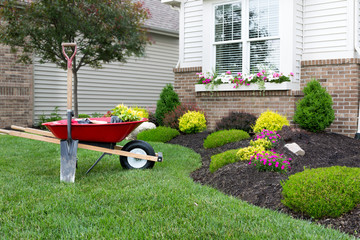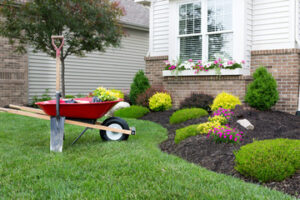
What Is Landscaping?
Landscaping encompasses everything on a property’s exterior, from plants to hardscape features like patios. Professional landscapers plan and install these elements and keep them looking their best by pruning, watering, weeding, and mulching.
 Landscaping Harrisburg PA has a wide range of tools and equipment that they can use to complete their work, including power mowers, edgers, leaf blowers, rototillers, and more. They are also skilled at identifying and selecting appropriate plants for each site. A landscaper must be able to interpret a client’s vision and translate it into an effective design. They must also be able to work well with a team and handle the physical demands of their job, which may include lifting heavy objects and working in awkward positions for long periods of time.
Landscaping Harrisburg PA has a wide range of tools and equipment that they can use to complete their work, including power mowers, edgers, leaf blowers, rototillers, and more. They are also skilled at identifying and selecting appropriate plants for each site. A landscaper must be able to interpret a client’s vision and translate it into an effective design. They must also be able to work well with a team and handle the physical demands of their job, which may include lifting heavy objects and working in awkward positions for long periods of time.
Creating unity in the landscape is accomplished by repeating design elements, such as lines, shapes, and colors. Repetition adds order and a sense of familiarity to the garden or outdoor space.
Many people enjoy aesthetically pleasing landscapes, and there are a number of ways to make a landscape more appealing. One way is to use a variety of textures, colors, and shapes. Another way is to create a sense of unity. This can be achieved by using simple repetition, such as lining up plants or arranging them in geometrical shapes, such as squares. Creating a visual hierarchy is also important. This means starting with a strong foreground, then moving into the middle ground, and then finishing with the background.
A good landscape design should be balanced, and this is where the hardscapes and softscapes come in. Hardscapes include things like pavers, patios, walkways, and walls, while soft scapes are the living elements in the landscape, such as trees, shrubs, and flowers. Adding lighting is an effective way to add interest and draw attention to certain areas of the landscape. Lighting can also help to create an atmosphere; for example, cool colors can evoke feelings of calmness and tranquility, while warm colors can evoke feelings of warmth and friendliness.
Creating an aesthetically pleasing landscape can be a challenge, but there are some basic principles that can help you achieve your goals. A great place to start is by determining what your objectives are. This will help you choose the right types of plants and materials to include in your landscape. Then, you can begin to plan your design.
The aesthetic experience of nature (CES) refers to the positive emotional and psychological responses people have to natural landscapes, which can include feelings of inspiration, peace, and harmony. However, the relationship between CES and ecological value remains unclear, as landscape aesthetics are largely dependent on human perception rather than a clear biophysical assessment of ecosystem properties.
Understanding how landscape aesthetics influence human perception of ecosystems is critical to designing effective conservation programs. It is possible to increase a landscape’s CES through the application of sustainable design practices, such as avoiding erosion and sedimentation and managing water quality and quantity. These methods can be applied to both natural and man-made landscapes.
Throughout the world, people have used landscaping for both aesthetic and practical purposes. The practice involves the addition of plants, changing the terrain, and constructing structures. It can be seen in the gardens built by the Romans and the Mayans as well as in the garden areas surrounding homes today. The function of landscapes can be to provide food, shelter, energy, and natural beauty. They can also be used to regulate water flow, prevent soil erosion, and create wildlife habitats.
Adding ornamental or edible plants to the landscape is one way to add color and texture. The types of plants chosen for the landscape can reflect the owner’s personality and preferences. Some like more neutral colors, while others choose vibrant and contrasting hues. Landscaping can also include the use of water features such as fountains, ponds, and waterfalls to provide both visual and auditory interest.
The structure of the landscape and its ecological functions are important for the well-being of humans as well as other organisms. The concept of ecosystem services and natural capital has gained popularity recently. This type of approach focuses on four categories of landscape functions: provisioning (production of goods and services), regulatory (regulation of material and energy flows), habitat functions and cultural and amenity functions.
The landscape can be changed by climate changes, human activities, or anthropogenic forces. These changes can occur over a small or large area and over short or long time spans. For example, the hole left by a tree falling in a forest is a local and temporary change, while an entire landscape may be affected by a hurricane.
Another function of the landscape is to provide a refuge or nursery for endangered plants and animals. The landscape can also act as a corridor or matrix that connects habitats. The movement of wildlife through the landscape depends on its connectivity. Some species prefer to move along hedgerows or paths, while others travel through the landscape in a network structure.
The landscape can also serve as an educational tool by showing the interconnection of natural processes and human activities. It can also promote environmental awareness by demonstrating sustainable practices and encouraging conservation of natural resources. In addition, the landscape can also play a role in improving mental health by providing a soothing and relaxing environment. Studies have shown that spending time in nature can lower stress levels, improve memory and boost feelings of happiness.
In addition to making a property more visually appealing, landscaping also can make a home or business more valuable. Maintenance is a key part of landscaping, and it includes tasks like pruning, weeding, mulching, watering, fertilizing, and pest control. Maintenance also involves ensuring that hardscape elements such as walkways, decks, fences, and retaining walls are in good repair.
The most common type of landscaping maintenance is mowing and trimming. Landscapers also remove weeds from garden and flower beds, cut and trim hedges, and prune trees and shrubs. In some cases, they might add water features to a yard, such as fountains and ponds. They can also install outdoor fire pits, patios, pavers, and fencing.
Other types of maintenance that landscapers perform include soil cultivation and aeration, mulching, planting and transplanting, and insect and disease control. They can also manipulate other natural features of a property, such as landforms and elevations, bodies of water, or wildlife. Landscapers often work on public and private properties such as parks, schools, neighborhoods, golf courses, and commercial buildings.
To ensure that they’re meeting quality standards, it’s important for landscapers to use a checklist. This tool can be used to inspect turf, trees, perennial beds, annual flower beds, and more before the landscaper leaves a job site. It can also help facility managers and homeowner’s association managers verify that landscaping workers are providing the best possible service to their members. This helps to ensure that each property is aesthetically pleasing and functional for everyone who uses it.
The job of a landscaper involves working outdoors in various weather conditions with sharp tools and equipment. They are also subjected to heat exposure and have the potential for a variety of injuries that could be debilitating. As such, it’s important that every landscaper takes the necessary precautions to protect their health and safety.
The first step to taking the right safety measures is understanding the land. This includes learning its topography, soil qualities, prevailing winds, and the system of native flora and fauna. This will allow the landscaper to plan for the future and prevent any issues that may arise later.
Another safety measure that must be taken into account is wearing proper gear. This includes long pants, sturdy shoes, gloves, and ear and eye protection. Additionally, landscaping workers should always wear high-visibility safety apparel when working near traffic. Lastly, the landscaper should take frequent rest breaks during strenuous work. Ideally, these breaks should be in a cool place, such as inside of a vehicle with the air conditioning running or in shade.
When it comes to equipment, landscaping professionals should always read the instructions for each specific piece of machinery they use and receive training on how to operate it safely. This will help reduce the likelihood of injury, damage, or accidents caused by improper usage. Additionally, it’s a good idea to keep the landscapers’ hands and feet away from moving parts of machinery and to keep their clothing and jewelry secured to avoid getting caught in the equipment.
While implementing these measures can be time-consuming and inconvenient, it’s important that landscapers take the necessary steps to stay safe while they are working. This is important not only for the sake of their own well-being but to ensure the continued success of their businesses as well.
In addition to implementing strict safety procedures, landscapers can also limit their liability by obtaining professional liability insurance and putting detailed disclaimers in their contracts. By doing so, they can avoid hefty fines and focus on growing their business rather than worrying about lawsuits and court cases.
